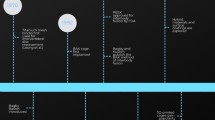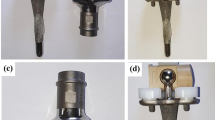Abstract
Introduction
The purpose of this study was to analyze explanted PEEK rod spinal systems in the context of their clinical indications. We evaluated damage to the implant and histological changes in explanted periprosthetic tissues.
Methods
12 patients implanted with 23 PEEK rods were revised between 2008 and 2012. PEEK rods were of the same design (CD Horizon Legacy, Medtronic, Memphis TN, USA). Retrieved components were assessed for surface damage mechanisms, including plastic deformation, scratching, burnishing, and fracture. Patient history and indications for PEEK rod implantation were obtained from analysis of the medical records.
Results
11/12 PEEK rod systems were employed for fusion at one level, and motion preservation at the adjacent level. Surgical complications in the PEEK cohort included a small dural tear in one case that was immediately repaired. There were no cases of PEEK rod fracture or pedicle screw fracture. Retrieved PEEK rods exhibited scratching, as well as impressions from the set screws and pedicle screw saddles. PEEK debris was observed in two patient tissues, which were located adjacent to PEEK rods with evidence of scratching and burnishing.
Conclusion
This study documents the surface changes and tissue reactions for retrieved PEEK rod stabilization systems. Permanent indentations by the set screws and pedicle screws were the most prevalent observations on the surface of explanted PEEK rods.






Similar content being viewed by others
References
Kurtz SM (2012) Applications of polyaryletheretherketone in spinal implants: fusion and motion presevation. In: Kurtz SM (ed) The PEEK Biomaterials Handbook. William Andrew, Elsevier, pp 201–220
Gornet MF, Chan FW, Coleman JC, Murrell B, Nockels RP, Taylor BA, Lanman TH, Ochoa JA (2011) Biomechanical assessment of a PEEK rod system for semi-rigid fixation of lumbar fusion constructs. J Biomech Eng 133:081009. doi:10.1115/1.4004862
Turner JL, Paller DJ, Murrell CB (2010) The mechanical effect of commercially pure titanium and polyetheretherketone rods on spinal implants at the operative and adjacent levels. Spine 35:E1076–E1082. doi:10.1097/BRS.0b013e3181df1b85
Highsmith JM, Tumialan LM, Rodts GE Jr (2007) Flexible rods and the case for dynamic stabilization. Neurosurg Focus 22:E11
De Iure F, Bosco G, Cappuccio M, Paderni S, Amendola L (2012) Posterior lumbar fusion by peek rods in degenerative spine: preliminary report on 30 cases. Eur Spine J 21(Suppl 1):S50–S54. doi:10.1007/s00586-012-2219-x
Mageswaran P, Techy F, Colbrunn RW, Bonner TF, McLain RF (2012) Hybrid dynamic stabilization: a biomechanical assessment of adjacent and supraadjacent levels of the lumbar spine. J Neurosurg 17:232–242. doi:10.3171/2012.6.SPINE111054
Siewe J, Otto C, Knoell P, Koriller M, Stein G, Kaulhausen T, Eysel P, Zarghooni K, Franklin J, Sobottke R (2011) Comparison of standard fusion with a “topping off” system in lumbar spine surgery: a protocol for a randomized controlled trial. BMC musculoskelet Disord 12:239. doi:10.1186/1471-2474-12-239
Aunoble S, Meyrat R, Al Sawad Y, Tournier C, Leijssen P, Le Huec JC (2010) Hybrid construct for two levels disc disease in lumbar spine. Eur Spine J 19:290–296. doi:10.1007/s00586-009-1182-7
Kurtz SM, Steinbeck MJ, Ianuzzi A, van Ooij A, Punt IM, Isaza J, Ross ERS (2009) Retrieval analysis of motion preserving spinal devices and periprosthetic tissues. SAS J 3:161–177
Ponnappan RK, Serhan H, Zarda B, Patel R, Albert T, Vaccaro AR (2009) Biomechanical evaluation and comparison of polyetheretherketone rod system to traditional titanium rod fixation. Spine J 9:263–267. doi:10.1016/j.spinee.2008.08.002
Ianuzzi A, Kurtz SM, Kane W, Shah P, Siskey R, van Ooij A, Bindal R, Ross R, Lanman T, Büttner-Janz K, Isaza J (2010) In vivo deformation, surface damage, and biostability of retrieved dynesys systems. Spine 35:E1310–E1316. doi:10.1097/BRS.0b013e3181d6f84f
Acknowledgments
The authors would like to thank Michael Beeman, David Jaekel, Madhuri Penmatsa, Christine Ho, Shannon Murphy, and Stephen Takemoto for their contributions to this study. This research study was supported by NIH R01 AR56264.
Conflict of interest
Institutional support has been received from Medtronic and Invibio for research unrelated to the current study. One of the authors (TL) is a consultant for Medtronic and collaborated on the design of PEEK rod systems.
Author information
Authors and Affiliations
Corresponding author
Rights and permissions
About this article
Cite this article
Kurtz, S.M., Lanman, T.H., Higgs, G. et al. Retrieval analysis of PEEK rods for posterior fusion and motion preservation. Eur Spine J 22, 2752–2759 (2013). https://doi.org/10.1007/s00586-013-2920-4
Received:
Revised:
Accepted:
Published:
Issue Date:
DOI: https://doi.org/10.1007/s00586-013-2920-4




